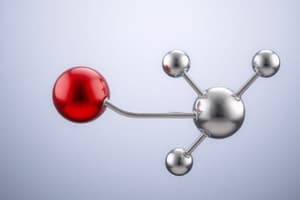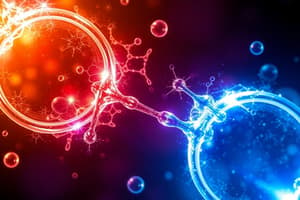Podcast
Questions and Answers
What is metallic bonding primarily a result of?
What is metallic bonding primarily a result of?
- Covalent bonding between metal atoms
- Ionic bonding between metal atoms
- Electrostatic attractive force between conduction electrons and positively charged metal ions (correct)
- Van der Waals forces between metal atoms
What properties of metals does metallic bonding account for?
What properties of metals does metallic bonding account for?
- High reactivity, low density, and translucency
- Malleability, low electrical conductivity, and dull appearance
- Brittleness, low melting point, and insulating properties
- Strength, ductility, thermal and electrical resistivity and conductivity, opacity, and lustre (correct)
In what form are the conduction electrons in metallic bonding?
In what form are the conduction electrons in metallic bonding?
- Shared equally between metal atoms
- Bound to specific metal ions
- Electron cloud of delocalized electrons (correct)
- Localized around individual metal ions
Which metal exhibits covalent bonding in addition to metallic bonding?
Which metal exhibits covalent bonding in addition to metallic bonding?
As chemistry developed into a science, what became evident about the periodic table of the elements?
As chemistry developed into a science, what became evident about the periodic table of the elements?
Explain ionic bonding and the type of atoms involved in it.
Explain ionic bonding and the type of atoms involved in it.
What are ions and how are they formed?
What are ions and how are they formed?
Differentiate between electrovalence and covalence.
Differentiate between electrovalence and covalence.
Provide examples of complex ions formed through ionic bonding.
Provide examples of complex ions formed through ionic bonding.
Explain the process that results in an ionic bond.
Explain the process that results in an ionic bond.
Flashcards are hidden until you start studying




